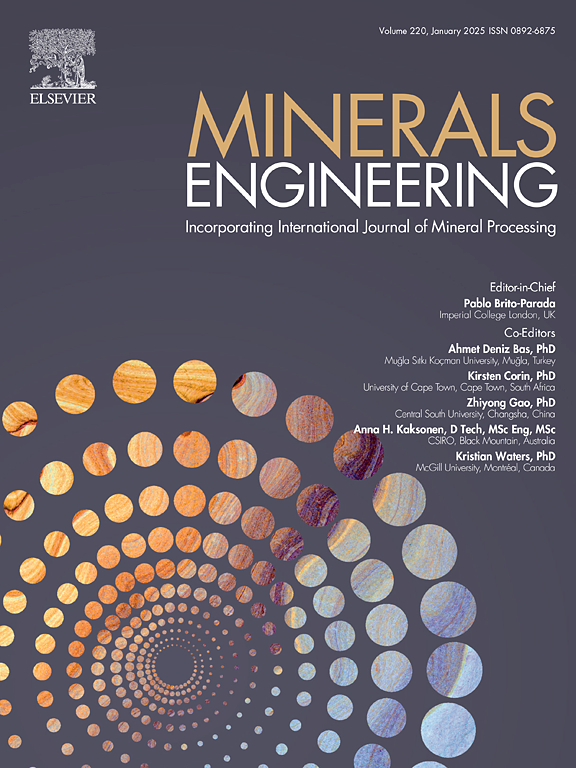里德山铁矿的综合方法:从表征到矿石加工
IF 5
2区 工程技术
Q1 ENGINEERING, CHEMICAL
引用次数: 0
摘要
本文介绍了加拿大魁北克某低品位铁矿石的综合工艺特征和初步选矿策略,旨在生产出高质量的直接还原精矿。这项工作的新颖之处在于其综合表征-处理方法应用于未开发的地质复杂矿床。采用Rietveld细化XRD、sem矿物解离分析和键功指数测试等先进方法对5个代表性样品进行了分析。矿石中粗溶出和细嵌布氧化铁的独特组合,特别是赤铁矿和磁铁矿的共存,没有明确的结构替代,给矿物分离带来了独特的挑战。该研究的一个关键贡献是确定了75µm以下的最佳解离粒度,这在加拿大的bif相关矿石中并不常见,并且证明了预富集阶段显著提高了弱磁选的性能,获得了铁和铁含量高达70.15%的铁精矿。2.5% SiO2(磁性矿石)。此外,该研究定量地将富锰岩性(含菱铁矿层)与较高的磨矿能量需求和对精矿质量的有害影响联系起来。基于这些发现,提出了一种适合磁铁矿和赤铁矿回收的分岔流程。研究结果强调了在低品位、复杂的铁矿系统中,细尺度工艺-矿物学整合对于开发可行的选矿路线的重要性。本文章由计算机程序翻译,如有差异,请以英文原文为准。
Integrated approach for Mont Reed iron ore: From characterization to ore processing
This study presents a comprehensive technological characterization and preliminary beneficiation strategy for a low-grade iron ore from Quebec, Canada, aimed at producing direct reduction (DR) quality concentrate. The novelty of this work lies in its integrated characterization-to-processing approach applied to an unexploited, geologically complex deposit. Five representative samples were analysed using advanced methods including XRD with Rietveld refinement, SEM-based mineral liberation analysis, and Bond Work Index testing. The ore’s unique association of coarse liberated and finely disseminated iron oxides, especially the coexistence of hematite and magnetite without clear textural replacement, posed distinctive challenges for mineral separation. A key contribution of the study is the identification of an optimal liberation size below 75 µm, uncommon among BIF-related ores in Canada, and the demonstration that a pre-concentration stage significantly improves the performance of low-intensity magnetic separation, yielding Fe concentrates with up to 70.15 % Fe and < 2.5 % SiO2 (magnetitic ore). Moreover, the study quantitatively linked Mn-rich lithologies (rhodonite-bearing layers) to higher grinding energy requirements and deleterious impacts on concentrate quality. Based on these findings, a tailored flowsheet was proposed with bifurcated circuits for magnetite and hematite recovery. The results emphasize the importance of fine-scale process-mineralogy integration for developing viable beneficiation routes in low-grade, complex iron ore systems.
求助全文
通过发布文献求助,成功后即可免费获取论文全文。
去求助
来源期刊

Minerals Engineering
工程技术-工程:化工
CiteScore
8.70
自引率
18.80%
发文量
519
审稿时长
81 days
期刊介绍:
The purpose of the journal is to provide for the rapid publication of topical papers featuring the latest developments in the allied fields of mineral processing and extractive metallurgy. Its wide ranging coverage of research and practical (operating) topics includes physical separation methods, such as comminution, flotation concentration and dewatering, chemical methods such as bio-, hydro-, and electro-metallurgy, analytical techniques, process control, simulation and instrumentation, and mineralogical aspects of processing. Environmental issues, particularly those pertaining to sustainable development, will also be strongly covered.
 求助内容:
求助内容: 应助结果提醒方式:
应助结果提醒方式:


